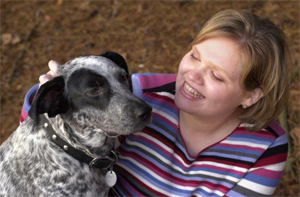
If you own a dog, cat, horse, or ferret, you might want to thank scientists in the NIAID Laboratory of Viral Diseases (LVD). Though their mission is to conduct research to improve human health, there’s a good chance your four-legged friend has benefitted from their work.
With work that began in the 1980s, Dr. Bernard Moss and colleagues in LVD developed a technology that today is used in vaccines that are protecting millions of animals from serious infectious diseases. The technology, licensed by animal product company Merial, Inc., in 2006 and developed into 16 different vaccines, has been used to safeguard companion animals, farm animals, and wild animals from diseases that are often fatal—including feline leukemia, rabies, distemper, and avian influenza.
Fighting Fire With Fire
The NIAID-developed technology uses a weakened, or attenuated, version of a poxvirus to introduce genetic material from the disease-causing virus to the immune system. This “recombinant” vaccine technology closely mimics natural infection and therefore does a good job of stimulating the immune system against disease. The vaccines carry only partial DNA from the viruses, so they are unlikely to cause disease in an otherwise healthy animal.
A poxvirus makes a good carrier, or vector, for vaccines for several reasons. First, it has a large genome, which offers plenty of room to carry other genetic material. It can latch on to a broad range of cells, so the chances of the vaccine entering the host’s immune system are high. Finally, it is highly unlikely to cause disease in an animal whose immune system is not compromised by other factors.
Improving the Status Quo
Using LVD poxvirus vector technology, Merial has developed vaccines that protect chickens and other birds from avian influenza; cats from feline leukemia and rabies; horses from West Nile virus and equine flu; wild animals from rabies; dogs from distemper, parvovirus, adenovirus, and parainfluenza; and ferrets from distemper. The vaccines are approved by the U.S. Department of Agriculture (USDA), and many are marketed worldwide. Merial’s Purevax line of vaccines for cats is the largest-selling feline vaccine line in the world, and the Recombitek vaccine lines for dogs and horses are widely used to protect these animals from a variety of diseases. More than 3 billion doses of the Trovac avian influenza vaccine have been sold.
The vaccines based on LVD technology have already helped save lives: According to USDA Animal Health Monitoring System, in 2006, there were 1,086 reported cases of equine West Nile virus in the United States. By 2008, after Merial’s Recombitek vaccine became available, reported cases had dropped to 178.
In Western Europe, reported cases of rabies in wildlife have dropped to zero following a campaign using Merial’s Raboral V-RG vaccine, an oral vaccine that enables health officials to immunize large numbers of wildlife efficiently. In the United States, the USDA National Rabies Management Program oversees distribution of Raboral in 16 states, with a goal of eliminating terrestrial rabies from this country. The vaccine is encased in solid bait and distributed to wildlife areas by airplane, helicopter, or hand. Wild animals eat the bait and,10 to 14 days later are immunized against rabies. About 12 million doses of the vaccine are distributed globally each year.
Dr. Moss and his colleagues are continuing to perfect pox vector technology for use in human vaccines, including AIDS vaccines. The most advanced AIDS vaccine developed using the LVD technology is now entering Phase IIa clinical trials. Meanwhile, for the health and well-being of a variety of animals, recombinant pox vector technology has already been a great success.

